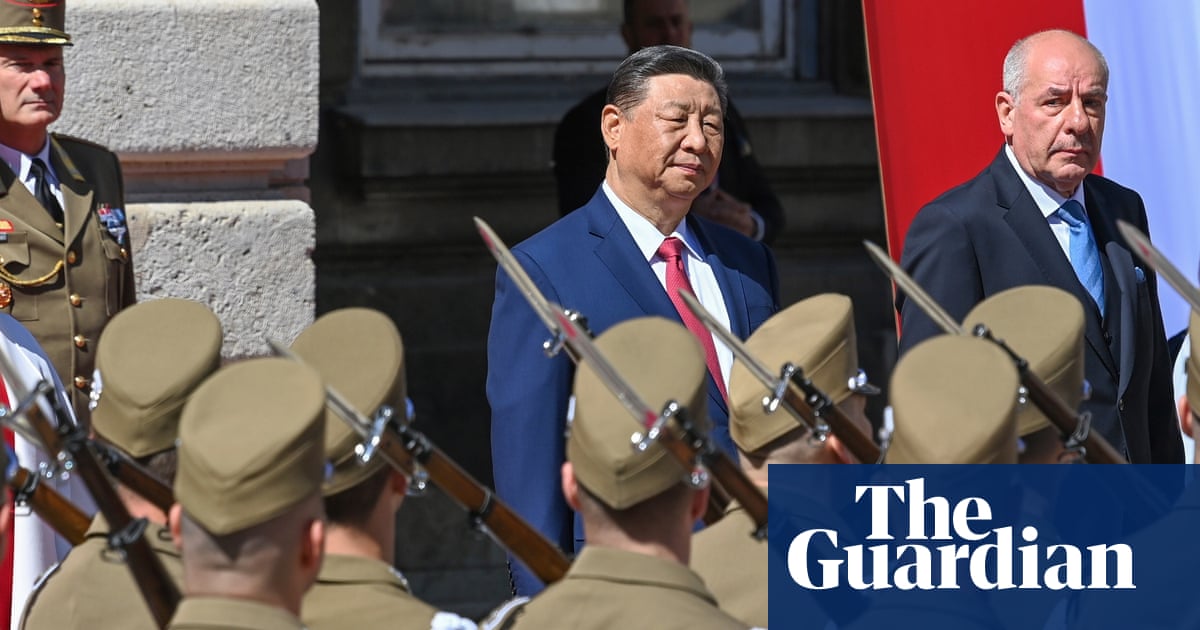


Hungary has rolled out the red carpet for Xi Jinping in a show of warmth that contrasts with wariness in the rest of the EU about China’s stance on trade, global politics and human rights.
On the third and final stop of his first European tour in five years, Xi was given a ceremonial welcome by Hungary’s president, Tamás Sulyok, at Buda Castle, in Budapest, before talks with Viktor Orbán. The Hungarian prime minister, the EU’s longest-serving leader, has sought to deepen ties with Beijing and blocked EU motions criticising China’s human rights abuses.
After that meeting, the Chinese state media agency Xinhua reported that China and Hungary had decided to elevate their ties to “all-weather comprehensive strategic partnership in the new era”. China has used a similar formula to describe its relations with Uzbekistan, Tajikistan and Venezuela.
Orbán said the two countries were going to expand their cooperation in “the full spectrum” of the nuclear industry. In a major departure from the European mainstream, the Hungarian prime minister said he supported China’s “peace plan” for Ukraine. Western leaders have criticised the 12-point plan, published in 2023, because it does not call on Russia to withdraw its forces or return territory.
Xi arrived in Hungary late on Wednesday, after stops in Serbia and France, and was met at the airport by Orbán. “Welcome to Hungary, President Xi,” Orbán posted on X with a picture of the two men shaking hands and smiling warmly.
Orbán’s political director, Balázs Orbán – no relation – told local media that Xi’s visit was “confirmation of the effectiveness of Hungary’s connectivity strategy”. In an article for Euronews, he wrote that “Europe must also recognise that the evolving geopolitical environment requires a strategy of prudent connectivity” and he hoped “cooler heads will soon have a chance to prevail”.
The EU in 2019 declared China “a systemic rival” and the European Commission president, Ursula von der Leyen, said last year that Europe needed to “de-risk” its relations with Beijing, meaning, in part, cutting dependency on Chinese supply chains.
Hungary, which is marking 75 years of diplomatic relations with Beijing, has distanced itself from the EU strategy.
The central European country has received billions in Chinese investment and hosts Huawei’s largest base outside China. The Chinese carmaker BYD will soon open a factory for electric vehicles in Szeged, southern Hungary, its first production line for battery powered cars in Europe, creating a significant challenge for European companies in the heart of the EU.
In comments carried on China’s state news agency, Xinhua, Xi said the Chinese-Hungary relationship was “now at its best in history”.
“The two sides should adhere to win-win cooperation, expand cooperation in various fields within the framework of the belt and road cooperation, and synergise their respective development strategies,” Xi said.
Hungary’s foreign minister, Péter Szijjártó, has said 16-18 cooperation agreements would be signed during Xi’s visit, one of which could be a large-scale infrastructure scheme within China’s vast belt and road project.
Meanwhile, a Hungarian lawmaker with the opposition Momentum party told Associated Press that he and a colleague had been approached by a group of men on Wednesday as they attempted to place EU flags on a Budapest bridge.
Márton Tompos said the men, all wearing red baseball caps, confronted him to make sure no flags or symbols referencing Tibet or Taiwan, claimed by China, would be hung on the route of Xi’s motorcade.
The visit to Hungary follows a similarly friendly welcome in Serbia, where President Aleksandar Vučić told Xi that “Taiwan is China”. Serbia has long backed China’s claim to the self-governing island and has Beijing’s support for its claim to Kosovo.
In France, von der Leyen warned Xi that Europe would not hesitate to protect its industries from China’s state-subsidised electric cars, steel, solar and wind technology. The European Commission has been promoting an alternative to the belt and road, the global gateway, to fund infrastructure projects worldwide.